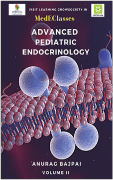Translate this page into:
Advanced Pediatric Endocrinology
E-mail: Garry Warne - garry@warnefamily.net

Title : Advanced Pediatric Endocrinology
Editor : Anurag Bajpai
Publisher : MedEClasses Private Limited, Kanpur, India
Printed by : MedEClasses Publications, Kanpur
Publication date : 2021
Vol : Vol 1: 324 pages, Vol 2: 340 pages
ISBN : Not provided
Cost : INR 6000 Available at learning.growsociety.in
Dr. Anurag Bajpai and his colleagues, mostly from Kanpur in North India, have developed teaching resources for trainees in pediatric endocrinology over a number of years through the MedEClasses online portal and have previously published a basic pediatric endocrinology textbook. This two-volume publication builds on that foundation by providing the level of detail required by advanced trainees and practitioners. It is an outstanding addition to the relatively small number of textbooks of pediatric endocrinology previously published with such distinguished editors as Brook, Sperling, and Lifshitz.
In appearance and presentation, Dr. Bajpai’s book is very beautiful, with abundant clear, relevant, and useful illustrations in full color. They are a major feature of the book, and it is surprising that the artists and designers are not acknowledged. The books were printed in Kanpur and they are a credit to the high quality of book production there. The 29 chapters in Vol 1 and 63 chapters in Vol 2 cover the entire range of topics in pediatric endocrinology. The writing style is consistent throughout (perhaps because Dr. Bajpai is the lead author on nearly all chapters). While clear and concise, it provides considerable detail and each subject is dealt with in some depth. It also appears to be right up to date. This book will appeal to readers throughout the world in that it avoids any particular focus on India. Nevertheless, the large number of excellent case vignettes throughout the book was no doubt possible because of the vast number of patients seen each year by Indian pediatric endocrinologists.
Controversial subjects, such as the management of children with intersex conditions, are dealt with very briefly and in a fairly didactic fashion and there is no lingering on psychological issues such as gender dysphoria.
The lack of an index is a surprising deficiency and the number of references given is limited to a shortlist of articles for further reading at the end of each chapter.
Overall, I applaud Dr. Bajpai and his team of co-authors on a really wonderful publication that I consider has set a new benchmark in the field. It will be extremely useful for advanced trainees and practitioners in the field of pediatric endocrinology internationally, not just in India. It shows very clearly how far pediatric endocrinology has advanced in India over the past 20–30 years and this is a great credit to the Indian Society of Pediatric and Adolescent Endocrinology.





